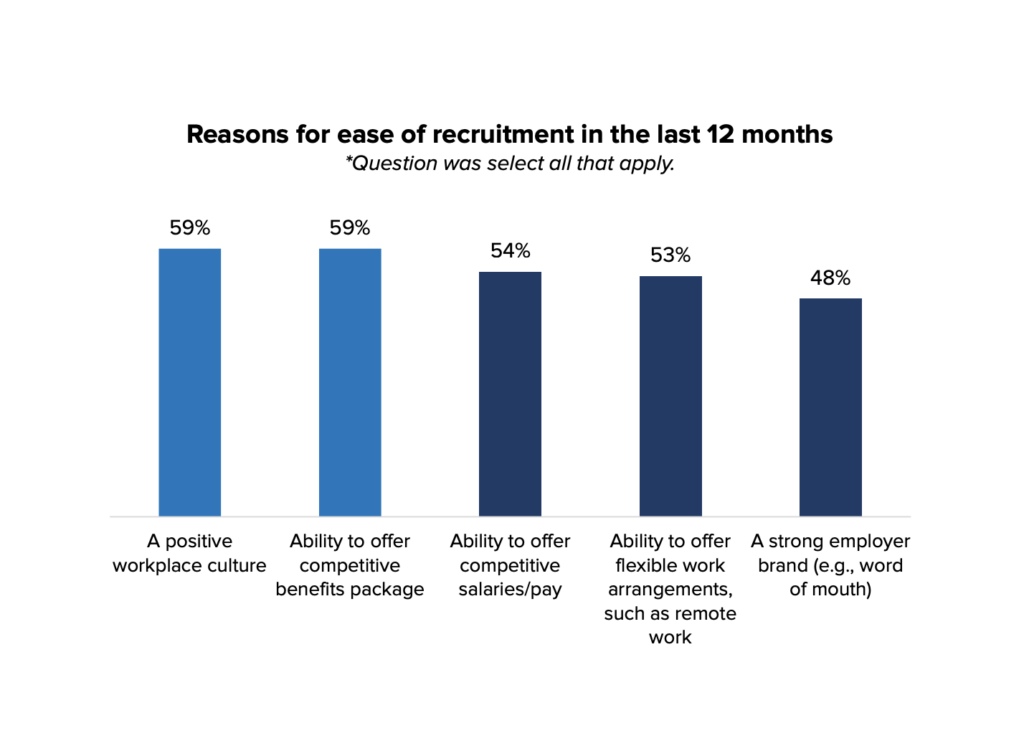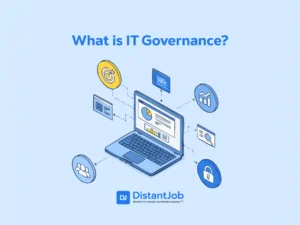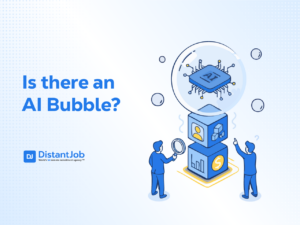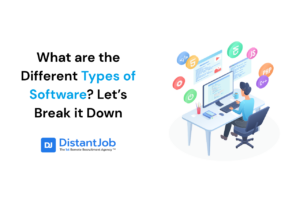The old way of hiring is not working anymore. Successful talent acquisition starts with engaging in human-focused hiring experiences, remote hiring, shifting from job-description-based recruitment to a skill-marketplace paradigm, and promoting your company’s culture/benefits as heavily as you promote your products. According to the 2024 SHRM Talent Trends report, 77% of companies are having a hard time finding candidates. Sixty percent of them find it hard to find qualified candidates, another 60% report not having enough candidates apply, and 51% require different skills due to tech changes. Companies need to adopt new talent acquisition methods to improve their ability to hire and retain people.
Luckily for you, we have the experience and have done the research to help you in your quest for talent acquisition.
Why is Talent Acquisition Still Challenging Today?
Talent acquisition specialists still struggle to find top talent due to widespread skill gaps, intense hiring competition, and complex hybrid skill requirements. 2024 McKinsey report states that 87% of executives are currently experiencing skill gaps. This is particularly true in technology fields, where specialized skills such as AI, cloud solutions, and data science are in high demand. As a result, the gap between supply and demand will continue to grow, putting even more pressure on recruiters.
Another factor is s that many companies are competing for the same employee. A 2024 survey from LinkedIn showed that 63% of employers are in a competitive hiring mode. This competition is expected to increase as the world matures, especially in industries such as technology, online services, medicine, and green energy.
Top 7 Talent Acquisition Strategies
To access wider and more diverse talent pools, improve time to hire, and increase retention, here are the seven talent aqusitions methods that we implemented and worked for us, recrutiers:
1. Human Touchpoint in Screening
As experienced recruiters who have guided thousands of hires, we’ve seen again and again that technology may accelerate screening, but it’s the human conversation that seals the deal. A Cronofy’s 2024 global survey of 12,000 candidates showed how 81% insisted having a human contact to “speak to” was crucial to continuing any process. CareerPlug’s 2025 research found 70% still feel most comfortable with live interviews, 40% are uneasy with fully AI-driven decisions, and 47% find chatbots impersonal.
It’s no wonder, then, that 62% of U.S. job seekers would not apply to companies that rely too much on generative AI in their recruitment process. Even Cronofy, whose research looked at the positive benefits of using automated systems to schedule interviews, highlighted that a recruiter’s “touch point” was still the most important factor for 81% of candidates.
That’s why we will always involve a recruiter in every part of our assessment process, and why we recommend you do too. Putting a person, not just a platform, in front of candidates demonstrates respect, an inclusive culture and that you care about the candidate as a person.
2. Source and Engage Talent The Right Way
Relying on mainstream job boards can definitely feel like fishing with a net—there sure will be quantity, but will there be quality? The chances are low. So what is the solution? Having a different approach.
A LinkedIn Talent Solutions report found that 70% of the world’s workforce are what’s called passive candidates: those who are not looking for a job but might be open to an interesting opportunity. If you rely only on job ads, you will miss out on most of the best people.
Go Where Your Prospects Are:
- Go into your targeted professionals’ habitats—their forums, Slack groups, and Discord servers—and invest time in getting to know them and have them get to know you. Connect as people; let the employer in you take a back seat.
- Partnering with educational institutions and community organizations, such as universities, vocational/technical/trade schools, high schools and community colleges, to develop a pipeline of candidates for harder-to-recruit positions.
Nurture Relationships for the Long Haul
Keep in mind that it’s not only about building relationships but making sure you nurture long-term relationships. For one, since your game plan has been laid out for at least 12 months, these connections you’re making now can come in handy later on. Also, because, let’s say you were already hiring for a position and the candidate you wanted wasn’t ready for a change just yet, it doesn’t mean they won’t be in the future. So, when you focus on staying in touch and keeping these passive candidates in the loop by sharing updates, inviting them to events, checking in, etc., you keep connections alive and doors open for when the right time comes.
Employee Referrals & Targeted Headhunting
Employee referrals are still very valuable, particularly from someone you trust.
But headhunting is the strategy we live and breathe for, and have been doing for years. This is the one talent acquisition strategy that ensures you’re fishing for the right fish in the right pond. This strategy works even better if you combine it with the previous steps since the candidate will see your company as the right pond or river back.
Although it may seem like a lot of work (and it is), you’ll see that by implementing these sourcing and engagement strategies to your overall TA strategy, you not only tap into and connect to high-quality candidates, but you also certainly build a significant pipeline that’ll be at your disposal when the need arises to fill a spot or build a new team.
3. Find Career-Driven and Skilled Talent for Soft Skills
With AI being the new player in the industry, you need people who don’t only adapt to change; they also push their careers forward when it happens. Career-driven individuals see change as an opportunity to pick up new skills and try new things. They are the type of people who will make sure your company is ahead of the curve and not just someone trying to catch up. A 2016 Pew Research Center survey, “The State of American Jobs,” found that 87% of workers believe it will be essential for them to get training and develop new job skills throughout their work life in order to keep up with changes in the workplace.

A Harvard Business Review study found that strong interpersonal skills could improve team performance by 30% or more. These skills include communicating clearly verbally and asynchronously, proactivity, problem-solving, conflict resolution, self- and time management, cultural literacy and sensitivity, autonomy, accountability, and empathy, to name a few important ones.
Of course, you need people with the technical ability to do their job, but all this goes down the drain if they can’t work with other people. So the key is to look for candidates that excel in both soft and hard skills.
You can start by:
a. Standardize and structure your screening process. This way all your interviewers will follow the same textbook, and therefore all your candidates are evaluated under the same criteria, preventing error and bias. These interviews should focus on technical skills, soft skills, cultural fit, remote readiness, ambition, among other things that’ll show you their adaptability in the workplace.
b. Implement some real-word assignments, some tasks that mirror actual tasks they’d have to work on if they get hired. This way, you can see not only their delivery but their thought process, their technical abilities, their communication style, and their personality.
c. Get their possible future coworkers involved in the interview process, as they can definitely help you in terms of checking how they’d mesh with the team, offering you some valuable insights when it comes to candidates’ interpersonal skills and teamwork that someone looking from the outside might miss.
And, finally, but very importantly, once you know who you want to hire, do it quickly, or you might lose them to someone else who will.
4. Shift to skills‑based, critical‑role hiring
By rewriting job description around demonstrable capabilities instead of academic credentials, you gain both in talent quantity and quality:
- Nine out of ten employers report that skills‑based hires outperform degree‑screened hires, and 94 % say they make fewer hiring mistakes.
- Only 17 % of firms know where to start with skills‑based hiring, yet 83 % now prioritise skills over degrees, according to LinkedIn’s Global Talent Report.
There’s already a shift underway in the market. Between 2021 and 2024, the proportion of UK job vacancies that didn’t specify a degree requirement increased by 14.2%. The World Economic Forum’s 2025 report shows why, with employers listing analytical skills, use of AI and resilience as among the top core skills, needed by seven in ten companies today, rather than paper qualifications. Focusing on skills is therefore the fastest, most equitable and most sustainable way to close skills gaps.
5. Be Ready to Change Your Hiring Game
Talent acquisition is a dynamic process and can be adjusted and refined, so it can be leveled up. What worked last year might not succeed in the next one. The employment market and the technology stacks constantly change. 91% of recruiters say agility in recruitment is key in finding top talent.
Keep testing new approaches, keep learning what works, and, most importantly, be ready to change things up when your old ways stop working. You can do that by:
Track Key Metrics
Track KPIs, such as time-to-fill, offer acceptance rates, and your new hires’ performance during their first six months is needed. These metrics will show you where your strengths are, and also your weaknesses, so you’ll know where and how to adjust.
Gather feedback, from all sides.
Getting feedback from everyone involved in the hiring process is really important because people’s experiences and perspectives can reveal blind spots that could harm you in the long run.
Iterate Fast
Don’t wait for problems to escalate; rather iterate quickly and proactively. If your KPIs or feedback bring any weak spots to your attention, act fast. Be it by tweaking your interview questions, improving your onboarding process, or adjusting offers to make them more competitive, do it. Iterating fast can save you from bigger problems down the road.
6. Develop an Effective Remote Employer Brand
A strong employer brand can make a big difference. Companies with strong employer brands are able to reduce their time to hire by 50% and increase the number of qualified candidates by about the same number.
According to LinkedIn’s 2024 Global Talent Trends report, 72% of talent acquisition professionals agree that employer branding is key to attracting top talent.
Work on promoting your company’s values on your website, job postings, and social media accounts. Highlight aspects of your remote work culture that promote work-life balance, inclusivity, and self-improvement.
7. Remote Hiring
Hiring remotely is still a valuable TA strategy in 2025. Offering remote positions significantly improves your chances of recruiting for full-time positions; 53% of employers that offer remote work said they will have no problem filling positions for their company in 2024.

Source: SRM.org
As a talent acquisition manager, going remote is the most valuable weapon to deal with all these issues—whether it’s not having enough candidates apply, dealing with more competition, or not finding people with the right skills. That’s because if you broaden your horizons beyond the local market you gain access to a much larger number of candidates and candidates with rare skills.
This is particularly important when companies are looking to hire for highly specialized positions or bring on staff who are able to work with new technology.
Conclusion
These talent acquisition strategies will drastically cut down on the time you waste on the wrong employees. They will also improve the quality of the hires you make and decrease the time it takes to integrate employees into your organization. The solution is to do targeted hiring right, proper integration and work on your employer brand.
While these steps take time to implement—especially if you decide to take the big jump of hiring international employees—they will increase the likelihood of hiring employees who want to stick around and create a stronger relationship with your employees in the future.
However, if you don’t have the time, you can always find an agency that specializes in remote recruitment such as us and will already have much of the system in place. Book a discovery call now!





